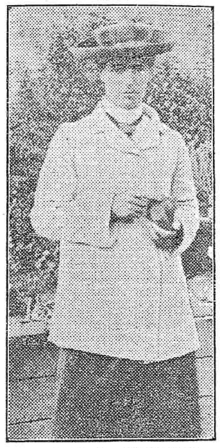Edith Rebecca Saunders
Edith Rebecca Saunders (born October 14, 1865 in Brighton , † June 6, 1945 in Cambridge ) was a British geneticist , biologist and phytotomine . JBS Haldane called her the mother of British plant genetics . Together with William Bateson , at the beginning of the 20th century, she laid the foundations for an understanding of Mendel's rules , the research results of which had been published by Mendel in 1866 but had been ignored by science until then. Her intensive research into the anatomy of flowers, with her special focus on the gynoeceum , the reproductive organs of flowers, ensured her high recognition in the professional world.
Life
Saunders first attended Handsworth Ladies' College and then, in 1884, Newnham College , attended only by young women .
In the three-part Tripos course system practiced at Cambridge University , Saunders reached level one in 1887 and level two in 1888, which leads to a bachelor's degree; both times with distinction. During her postgraduate studies , she taught botany at the Balfour Biological Laboratory for Women between 1888 and 1890 to students at Newnham and Girton Colleges who were preparing for their own degrees. She headed the laboratory herself from 1890 to 1914 and was also director of studies at Girton College from 1904 to 1914 . From 1918 to 1925 she headed Newnham College.
She was the second woman , after Dorothea Pertz , to be elected a member of the Linnean Society of London in 1905 . In 1906 she was appointed a member of the Royal Horticultural Society , and this society immediately honored her with a high distinction, the Banksian Medal . In 1920 she assumed the presidency of the botanical section of the British Association for the Advancement of Science and held the same position at the Genetics Society from 1936 to 1938 .
Edith Rebecca Saunders was not only professionally connected to Dorothea Pertz, but also on friendly terms.
During the Second World War she served with the Allies as a volunteer in the medical service. She died in 1945 as a result of injuries in a bicycle accident. Saunders remained unmarried.
Act
Saunders' initial research focused on genetics. She and Bateson showed important results that alleles , a small “piece of data” in a diploid chromosome set , according to the long-forgotten Mendelian rule, play an important role in the inheritance of traits and attributes. The starting point for this was the crossbreeding studies and the results obtained on the dominance and recessivity of characteristics of the examined individuals . For this she discovered along with Bateson and Punnett the genetic linkage .
Saunders carried out her research on the anatomy of plants intensively, with a particular focus on the gynoeceum . In addition, she published a remarkable series of articles in the botanical journal New Phytologist , which she also illustrated with the corresponding drawings of the fruit and stamens .
During the time of her career, she made several research trips to Australia, East Asia and South Africa.
Works by Edith Rebecca Saunders
- Floral morphology; a new outlook with special reference to the interpretation of the gynaeceum ; Published by W. Heffer & Sons Ltd., Cambridge, 1937-1939
- Matthiola ; Published by 's-Gravenhage, 1928
- Floral morphology ; Published by W. Heffer & Sons Ltd., Cambridge, 1937-1939
- Further experiments on the inheritance of "doubleness" and other characters in stocks ; Published by Cambridge University Press 1911
- with Bateson, W .: Experimental studies in the physiology of heredity ; Published by sn, 1904 ?, London
Secondary literature
- Richmond, W .: Women in the early history of genetics. William Bateson and the Newnham Colege : Mendelians, 1900-1910
- Richmond ML: The 'domestication' of heredity: the familial organization of geneticists at Cambridge University, 1895-1910 ; Dordrecht, 2006
proof
- ↑ a b Edith Rebecca Saunders entry on Encyclopædia Britannica: http://www.bridica.com/EBchecked/topic/1758746/Edith-Rebecca-Saunders
- ↑ JBS Haldane: Miss ER Saunders . In: Nature . 156, No. 3961, 1945, p. 385 (English). doi : 10.1038 / 156385b0 .
- ↑ a b c d e Staffan Müller-Wille : Saunders, Edith Rebecca , Lexicon of important natural scientists, 2007, Volume 3; Elsevier GmbH, Munich; P. 246; ISBN 3-8274-1883-6
- ↑ Kara Rogers: Balfour Biological Laboratory. Encyclopædia Britannica, accessed March 24, 2020 .
- ^ ML Richmond: "A Lab of One's Own": The Balfour Biological Laboratory for Women at Cambridge University . In: Isis . 88, No. 3, 1997, pp. 422-455. doi : 10.1086 / 383769 . PMID 9450359 .
- ^ ML Richmond: Opportunities for women in early genetics . In: Nature Reviews Genetics . 8, No. 11, 2007, pp. 897-902. doi : 10.1038 / nrg2200 . PMID 17893692 .
- ↑ Christine Alexander: Edith Rebecca Saunders. Genetics Society, accessed March 24, 2020 .
- ↑ Bateson, W. and Saunders, ER (1902) The facts of heredity in the light of Mendel's discovery. Reports to the Evolution Committee of the Royal Society, I. pp 125-160
- ^ Ingrid Lobo: Discovery and Types of Genetic Linkage. Nature , accessed March 25, 2020 .
| personal data | |
|---|---|
| SURNAME | Saunders, Edith Rebecca |
| BRIEF DESCRIPTION | British geneticist, biologist and phytotomine |
| DATE OF BIRTH | October 14, 1865 |
| PLACE OF BIRTH | Brighton |
| DATE OF DEATH | June 6, 1945 |
| Place of death | Cambridge |

